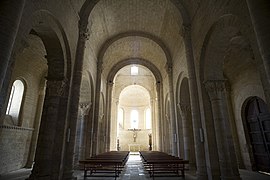Church of Saint Martin of Tours, Frómista

The Church of Saint Martin of Tours, in
History

The construction of the church was begun in the second half of the 11th century by will of Queen Muniadona of Castile, as part of a monastery, which has disappeared. The church is mentioned for the first time in 1066, and is stylistically connected to other Romanesque edifices in the Way of St. James, such as Cathedral of Jaca or San Isidoro de León.
In 1118 it was assigned to the Benedictine priory of
In 1894 it was declared a
Description
Saint Martin of Tours, Frómista has a typical Romanesque exterior. The three-level façade shows the differing height of the nave and aisles of the interior; at the sides are two cylindrical bell towers. The transept is as high as the central nave. Horizontally, it does not exceed the aisles. In the crossing, the interior extends upward into an octagonal dome. The nave and the aisle, covered with barrel vaults, end with three apses.
The church has four entrances, one in the north, one in the west and two in the south. However, only two are currently used. The walls have a solid appearance, with the few windows enclosed in rounded arches. All the four sides are topped by some 300 modillions with human, animals and fantastic figures, including some erotic scenes. Above the main portal is a chrismon with six arms.
One of the most remarkable facts of Frómista's sculpture is that the famous "Maestro de la Orestíada", also called "Maestro de Jaca-Frómista", worked on it. This author was inspired by a Roman sepulchre coming from the nearby Palencia town of
-
Plan
-
Left aisle
-
Central nave IRINEU
-
Crossing tower
-
Capital
The interior is on a basilical plan, with four bays separated by piers. The naves are separate by relatively low arcades. The central nave has no clerestory. As the barrel vaults of central nave and transept begin just at the top level of those of the aisles. that way, the building is a pseudobasilica.[1]
The apses have several medieval sculptures, including a 13th-century Christ in the nave. Some of the capitals have motifs of plant life, human figures or depictions of stories, such as that of Adam and Eve or the Fox and the Grapes.
References
Sources
- Lagunilla, Ramón (2010). San Zoilo de Carrión en el origen del románico pleno. El románico de las donnas. ISBN 978-84-613-9059-5.
External links
- Detailed description of the church, including 3D Virtual visit (in Spanish and English)
- The Art of medieval Spain, A.D. 500-1200, an exhibition catalog from The Metropolitan Museum of Art Libraries (fully available online as PDF), which contains material on this cathedral (no. 90)
- Photos and videos of the Church of Saint Martin of Tours
- 3D reproduction of its previous state.





